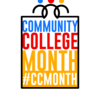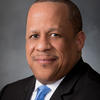April is Community College Month, though at Hope our celebration of community colleges isn’t relegated to a single month. Community colleges are crucial players in making higher ed more accessible and equitable. And you simply can’t talk about student basic needs security without talking about community colleges.
Because they play such a vital role in providing higher education to structurally marginalized communities, I sat down with Dr. Kevin Christian—Director of Diversity, Equity, and Inclusion (DEI) at the American Association of Community Colleges (AACC)—to talk about trends in DEI at community colleges, the intersection of DEI and basic needs, and the introduction of AI as it relates to DEI work. At a time when the mere acronym has been politicized and weaponized, Dr. Christian’s role is more important than ever.

What do you do in your role at AACC?
My role encompasses a great deal though my main focuses are on analyzing trends in DEI at community colleges and ensuring that DEI is infused at all levels of AACC’s work.
It’s [DEI work] dictated from the top down, but it has to come from the bottom up too, so that you meet in the middle so that it’s successful. DEI work—specifically the I—is crucial to the mission of community colleges.
Community colleges were founded on the ability to give access. It was access for those who had family commitments, lacked funding, or did not meet the requirements to get into a four-year institution. So, yes, populations that traditionally did not go to four-year institutions started at community college and it gave them access to post-secondary education.
What does DEI mean to you?
To me, it’s about equity across the board. DEI must be an institutional commitment for colleges and universities—that is, there must be funding, and it must be visible in the work. Some colleges make it visible by making it a proud part of their mission and they proclaim its importance in everything they do. Others don't have to say a word, but they make it clear through their branding and actions, including being intentional about the people they hire.
What are the trends you’re seeing in DEI at community colleges?
Among the trends: an increase in students enrolling in dual enrollment classes, an increased dedication to serving previously and currently incarcerated students, and increased attention to the future that comes with AI.
To give people the opportunity to, after they have completed their [prison] incarceration to earn skills and education that will be relevant and useful in the job market... it provides them a pathway to reenter society and provide for themselves and their families—especially after being away for such a long time.
We’re moving on the fast track. Technology has changed so much.
What has the introduction of AI into higher ed been like, specifically as it relates to DEI?
I have seen a lot of negativity surrounding the introduction of AI in higher ed but I believe it could be a good thing for DEI work.
Let me give you an example: a first-generation Chinese student used ChatGPT in one of her classes to translate a paper that she wrote in Chinese into English. On one hand—it's hard to say whether this work accurately reflects the student’s work. But on the other, this use of AI allows for a more level playing field for those who do not speak English as their first language.
If every student who enters a community college has an equitable opportunity to possess that skill or be involved with AI at some level, that will be a useful tool for leveling the playing field.
What do people get wrong about community colleges? What are some myths that need to be dispelled?
The first myth I’d like to refute is that community colleges classes aren’t rigorous. Anyone who has taken one knows this isn’t true. They are as rigorous as they come; they go through the same vetting and accreditation processes of four-year universities.
Another myth I want to disprove is that community college credits don’t transfer to four-year institutions. Many four-year colleges and universities rely on community colleges for their enrollment—it's in their interest to make it as easy as possible for students with dual enrollment credit or associate degrees to matriculate.
It’s also simply not true that employers don’t hire community college students. Now more than ever, employers from local businesses to Fortune 500 companies are hiring community college students. Many of them even have specialized programs to train students attending community college for jobs when they come out.
If you could wave a magic wand, what would you change for community colleges?
In terms of change for DEI in higher ed, introducing students to the prospect of post-secondary education at a younger age would pay off. Those in grades as low as sixth would benefit from getting this on their minds early to ensure they don’t miss the best option for them—whether that be community college, a technical college, or another type of institution—when it comes time to decide on a path, they have some context and knowledge of college. This is especially helpful for first-generation college students, or any others who may receive less support or have less knowledge of higher ed.
Why are both basic needs security and DEI important to community colleges, and how do those things intersect?
Meeting basic needs is essential for any student to be successful. Period, it’s essential. In order for us, as a sector, to understand everything that our students go through, understanding their basic needs is critical. Most community colleges have addressed this by providing resources to students to address hunger, transportation, housing, and even basic medical care.
One college that I visited not only had support for food, but for personal hygiene as well. They provided toothbrushes, soap, washcloths, and more.
To really meet peoples’ need, you need to make them feel like they belong and make them feel included in the work you’re doing with and for them. From a DEI perspective, this means seeing things from the perspective of the population you serve, and hiring those who can do that. Students need to feel like they will be heard before they ask for help.
I get to go out to a number of our member institutions, and I get to see what they are doing for their students. If they feel they are being heard, if they feel like they belong, if they feel like you want them to be successful, if they feel like the institution has their best interests at heart, they have no problem with being vulnerable and very open.
I remember when I was in school and there were days I didn’t have anything to eat. Or I didn’t have gas money—and I was fortunate. I was able to go to a four-year private college. I had two parents. I went as a traditional age student that went full time. But I still had some of those challenges that others have.
And then I look and I admire a number of community college students because I’m like, ‘How in the world did you do that? With everything that you were up against?'
DEI work is hard work—and uncomfortable work. But I urge those involved to consider that major change should be uncomfortable, and to consider the discomfort a sign of progress.

Dr. Kevin Christian
Director of Diversity, Equity, and Inclusion at AACC
It was the commitment. When they saw that the institution was committed to their success, and they had resources and opportunity across the board, it doesn’t get any better than that. I encourage institutions to make sure that they make DEI decisions based on data—but to never forget the human side. It’s crucial to remember that other people—especially students—can see things differently.
When you have people who embrace that, when you have institutions who embrace that...I think you’re on the right track.
DEI work is hard work—and uncomfortable work. But I urge those involved to consider that major change should be uncomfortable, and to consider the discomfort a sign of progress.
But I think as an institution of higher learning, any decision that you make that is tied to making a situation better, making an outcome better, making resources and policies equitable and available to those who they may affect is a step in the right direction. I think you’re going to come out on top, eventually.
The goal at the end of the day is to do the right thing. But even sometimes the right thing can become political or different and lands you in hot water. But if you stand in it and say, ‘I did this because it is right, it is wise,” I think eventually over time you will begin to see the return on your investment.


